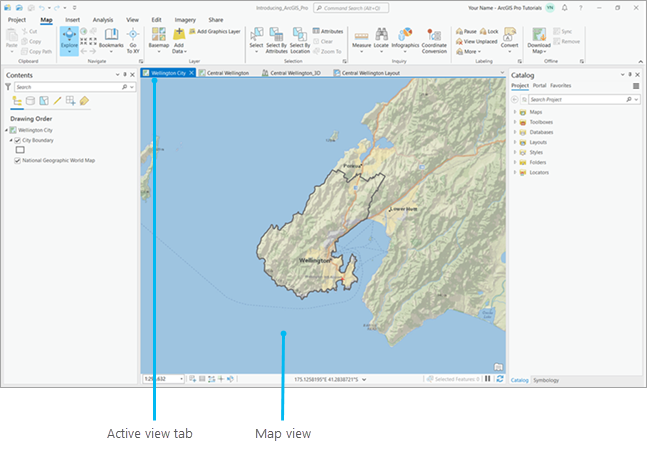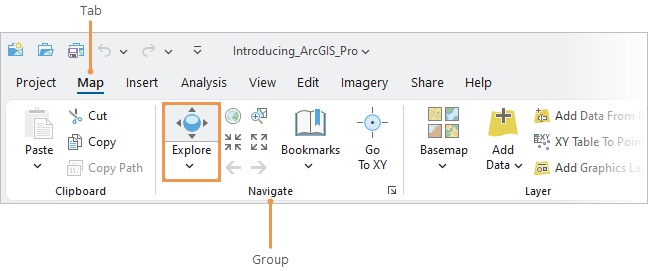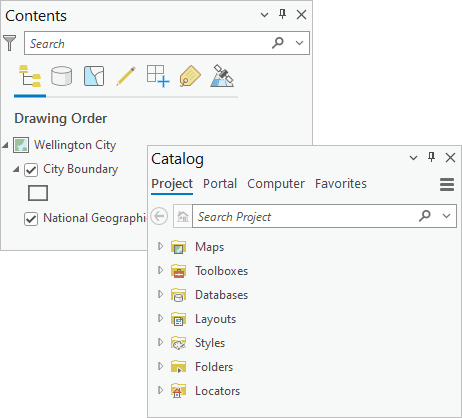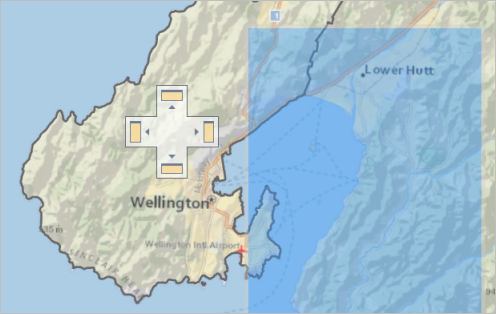ArcGIS Pro is a ribbon-based application. Many commands are available from the ribbon at the top of the ArcGIS Prowindow; more complex or specialized functionality is found on panes (dockable windows) that can be opened as needed. ArcGIS Pro allows you to store multiple data views—maps, layouts, tables, and charts—in a single project and keep them open at the same time. It also responds contextually to your work. Tabs on the ribbon change depending on the view and data you are working with. In this tutorial, you'll explore the main components of the ArcGIS Pro user interface—the ribbon, views, and panes—and their interactions.
Open the project
You'll explore an ArcGIS Pro project containing 2D and 3D maps of Wellington, New Zealand.
- Start ArcGIS Pro.If you are licensing ArcGIS Pro through an ArcGIS Online or Portal for ArcGIS account, you are probably signed in to the application already. However, if you are prompted to sign in, type your user name and password on the ArcGIS Sign In screen and click Sign in.
If you have no recent projects—for example, if this is your first project—you'll see templates for creating new projects arranged horizontally on the start page.

If you have recent projects, you'll see them arranged horizontally. The templates for new projects will be arranged vertically on the right side of the page.

- Click Open an existing project or Open another project, according to the option shown on your start page.The Open project page opens. The blue column on the left has tabs for opening and saving projects as well as many other options. The Open tab is selected. Next to this column, under the Open heading, you can choose to open recent projects, projects on your computer, or projects stored in a portal, such as your ArcGIS Online organization.
- Under the Open heading, click Computer. Click Browse
 .
.
- On the Open Project dialog box, browse to Introducing_ArcGIS_Pro.aprx and click OK.The file will be in a tutorial data folder with the same name, such as C:\ArcGISProQuickstartData\Introducing_ArcGIS_Pro.

When the project opens, you see a map of Wellington, New Zealand. The window containing the map is a map view. The colored tab at the top of the map view tells you that the view is active. The name of the view is Wellington City.
Use tools on the ribbon
Above the map view is the ribbon. The ribbon has a set of core tabs—Map, Insert, Analysis, View, Edit, Imagery, and Share—that are always present when a map view is active. Each tab has its own set of tools, organized in groups. The Maptab, selected by default, has tools for interacting with the map. On the Map tab, the Explore  tool is selected in the Navigate group.
tool is selected in the Navigate group.
 tool is selected in the Navigate group.
tool is selected in the Navigate group.
To get started, you'll use a couple of tools in the Navigate group. The Explore  tool is a common and versatile tool—it allows you to move around the map as well as to get information about map features of interest.
tool is a common and versatile tool—it allows you to move around the map as well as to get information about map features of interest.
 tool is a common and versatile tool—it allows you to move around the map as well as to get information about map features of interest.
tool is a common and versatile tool—it allows you to move around the map as well as to get information about map features of interest.
- With the Explore
 tool selected on the ribbon, drag the map to a different location.If you venture too far, it may be hard to find your way back. That's okay—a bookmark will return you to your starting place.
tool selected on the ribbon, drag the map to a different location.If you venture too far, it may be hard to find your way back. That's okay—a bookmark will return you to your starting place.
- On the ribbon, on the Map tab, in the Navigate group, click the Bookmarks
 drop-down menu. Under Wellington City Bookmarks, click Wellington.The map returns to its original extent. If you don't know much about Wellington, clicking the map feature will give you some information.
drop-down menu. Under Wellington City Bookmarks, click Wellington.The map returns to its original extent. If you don't know much about Wellington, clicking the map feature will give you some information. - On the map, click inside the city boundary for Wellington.

The city boundary flashes and a pop-up opens with information about the city's population. - Close the pop-up by clicking Close
 in the pop-up title bar.Besides the map view and the ribbon, you may see a Contents pane, a Project pane, or both. Panes are windows that help you manage views and projects, or that give you access to specific functionality. The Contents pane lists items in the active view, such as map layers. The Project pane lists items saved or associated with the project, such as databases, toolboxes, and folder connections. The Project pane also provides access to portal items, such as web layers.
in the pop-up title bar.Besides the map view and the ribbon, you may see a Contents pane, a Project pane, or both. Panes are windows that help you manage views and projects, or that give you access to specific functionality. The Contents pane lists items in the active view, such as map layers. The Project pane lists items saved or associated with the project, such as databases, toolboxes, and folder connections. The Project pane also provides access to portal items, such as web layers.

It's okay if you don't see these two panes, or if you see other panes. Pane states depend on the application, not the project. If you closed a pane in your last ArcGIS Pro session, it will still be closed when you start a new session, no matter which project you open. If you arranged your panes in a certain way in your last session, they will still be arranged that way now.To learn more about ribbons, views, and panes, see About ArcGIS Pro.
Open and dock panes
As you work, you'll often open and close panes that you need for specific tasks. You may also want to reposition panes or minimize them to make room for maps and other views.
- Click Close
 in the upper right corner of any open panes.Most of your application window is now given to the active view. You may like this configuration, but it's usually helpful to have the Contents pane open to help you manage your active view. It's often good to have the Project pane open as well.
in the upper right corner of any open panes.Most of your application window is now given to the active view. You may like this configuration, but it's usually helpful to have the Contents pane open to help you manage your active view. It's often good to have the Project pane open as well. - On the ribbon, click the View tab. In the Windows group, click Contents
 .The Contents pane opens.
.The Contents pane opens. - On the View tab, in the Windows group, click the Project drop-down menu and click Project Pane
 .The Project pane opens. The two panes appear in the positions they occupied before you closed them. They may be docked on opposite sides of the ArcGIS Pro window, or one may be stacked on top of the other. If the panes are stacked, they will have tabs at the bottom that allow you to switch from one to the other.
.The Project pane opens. The two panes appear in the positions they occupied before you closed them. They may be docked on opposite sides of the ArcGIS Pro window, or one may be stacked on top of the other. If the panes are stacked, they will have tabs at the bottom that allow you to switch from one to the other.

- Drag the Project pane by its title bar over the map view.

As you drag the pane, docking targets appear in the center of the map view. Each target represents an area of the screen where the pane can be positioned. - Hover over a docking target.You can see where the pane will be docked if you drop it on that target.
- Drop the pane on a target.The pane displays in its new position. If your Project and Contents panes were stacked before, they remain stacked and move together.
- Drag the Project pane away from its new position and drop it anywhere over the ArcGIS Pro window that is not a docking target.The pane floats. You can resize it by dragging a corner or a side of the pane.
- If the Project and Contents panes are stacked, click the Project tab at the bottom of the Project pane and drag the pane by this tab to a new locationThe panes are now separated.
- Arrange the two panes however you like. If you want to stack them, drag one pane over the other and drop it on the center docking target that appears.

By default, panes stay open as you work. You can autohide a pane so it doesn't take up space when you are not using it. - If necessary, click the Contents pane to make it active. In the upper right corner of the pane, click Auto Hide
 .
.

The pane is hidden along the edge of the ArcGIS Pro window in the area where the pane is docked. If your panes are stacked, both are autohidden. - Click the autohidden Contents pane to restore it.The pane stays open as long as you work with it. When you make a view or a different pane active, the Contents pane will autohide.
- Click Auto Hide
 to pin the pane in place again.
to pin the pane in place again.
Explore views
The Wellington City map is one of four views in the project. An ArcGIS Pro project can contain multiple maps, scenes (which are 3D maps), and map layouts, as well as other views, such as tables and charts. Several maps can be open at the same time. Maps can also be linked so they pan and zoom together. You'll learn how to link maps in the Navigate maps and scenes tutorial. For now, you'll look at the views in this project.
- Click the Central Wellington map view tab to make the view active.

The map shows buildings in the central business district around Lambton Harbour. - In the Contents pane, click the small gray arrow next to Buildings to expand the layer.The yellow and orange colors indicate the amount of solar radiation the buildings receive.
- Make the Central Wellington_3D view active.

The same buildings are shown in a scene. - On the ribbon, click the Map tab.
- In the Navigate group, click the Bookmarks
 drop-down menu. Under Central Wellington_3D Bookmarks, click Jervois Quay.You see the buildings from a different perspective.
drop-down menu. Under Central Wellington_3D Bookmarks, click Jervois Quay.You see the buildings from a different perspective. - Go to the View from Lambton Harbour bookmark to view the scene from another perspective.
- Make the Central Wellington Layout view active.

The ribbon changes to show tabs and tools for working with layouts. The Map tab has been replaced by a Layout tab. The Edit and Imagery tabs are gone.
The Contents pane lists the elements in the layout—its legend, map frames, text, and so on. They are listed in their top-to-bottom drawing order.

You can use the icons at the top of the Contents pane to organize these layout elements in different ways. It might be easier to find and work with specific elements if they were grouped by type. - In the Contents pane, click List By Element Type.

The layout elements are now grouped by type instead of drawing order. - Scroll to the bottom of the Contents pane.

Now it's easy to click the text elements in the Contents pane to select the one you want to work with on the layout. - On the Central Wellington Layout view tab, click Close
 to close the layout view.The view has been closed but still belongs to the project.
to close the layout view.The view has been closed but still belongs to the project. - In the Project pane, under Project, expand Layouts.

- Right-click Central Wellington Layout and click Open.The layout view opens. To learn how to make a map layout like this one, try the Make a layout tutorial.
- In the Project pane, under Project, expand Maps.The maps and scenes in the project are listed. You can open map views from the Project pane in the same way as layout views. Some other types of views, such as charts, are managed from the Contents pane.
Work with contextual tabs
You have seen that the tabs on the ribbon change depending on the active view. Within a view, different contextual tabs become available depending on the layer or data you are working with.
- Make the Central Wellington view active.
- In the Contents pane, click the Buildings layer to select it.In the Contents pane, the selected layer is highlighted in blue. Once it is selected, a Feature Layer contextual tab appears on the ribbon. Under it are three tabs with tools specific to feature layers.

- In the Contents pane, click Central Wellington.

The Feature Layer contextual tab goes away because no feature layer is selected. - In the Contents pane, click the Parks layer to select it.The Feature Layer contextual tab reappears.
- On the ribbon, under Feature Layer, click the Data tab.The Data tab has tools for working with the attributes of the selected feature layer.
- On the Data tab, in the Table group, click Attribute Table
 .
.

A table view opens with the Parks layer attributes. Each park has a name and address. On the ribbon, the Feature Layer contextual tab is still present. In addition, the Table contextual tab appears. It has a View tab with tools for working with tables. - On the ribbon, under Table, click the View tab.The tab has tools for adding and deleting fields, changing field properties, calculating table values, and more. In this tutorial, you don't need to make any changes to the Parks table.
- Close the Parks table view.The Table contextual tab is removed from the ribbon.
- On the ribbon, under Feature Layer, click Appearance.On the Appearance tab, you can set a visibility range for a layer, adjust its transparency, and choose a symbology method. When you choose a symbology method, a new pane will open with more tools.
- In the Drawing group, click the Symbology drop-down menu and click Single Symbol.

The Symbology pane opens.
- In the Symbology pane, next to Symbol, click the green symbol patch.The pane now presents options for formatting polygon symbols. At the top of the pane is a Gallery tab, which is active (blue), and a Properties tab. On the Gallery tab, you can choose a predefined symbol. On the Properties tab, you can modify symbol properties, such as color and outline width.
- On the Gallery tab, in the list of symbols, click Park.

In the map view, the parks are drawn with the new lighter green symbol. It doesn't look bad, but you might prefer the original symbol.Above the ribbon, the Quick Access Toolbar has buttons for undoing and redoing actions.

- On the Quick Access Toolbar, click the Undo
 button.The original green symbol for parks is restored
button.The original green symbol for parks is restored - Close the Symbology pane.
- On the ribbon, click the blue Project tab.You are taken back to the Open project page.
- In the blue column on the left, click Save to save the project.
The project is saved and returns to the map view so you can continue working. Feel free to continue exploring this project on your own. If you like, you can switch to the dark theme, which gives ArcGIS Pro a different look.

To switch themes, on the ribbon, click the Project tab. On the Open project page, click Options. In the Options dialog box, under Application, click General. On the right side of the dialog box, under Personalize, set the Theme to Dark and click OK. You'll need to restart the application for the change to take effect.
Functionality in ArcGIS Pro is accessed from the ribbon and from panes that respond contextually to the view and data you are working with. You can configure your workspace by docking panes and views where you like. If you repeat certain workflows regularly or use some tools more frequently than others, you may want to customize the ribbon by adding or removing tools from tabs.
ليست هناك تعليقات:
إرسال تعليق